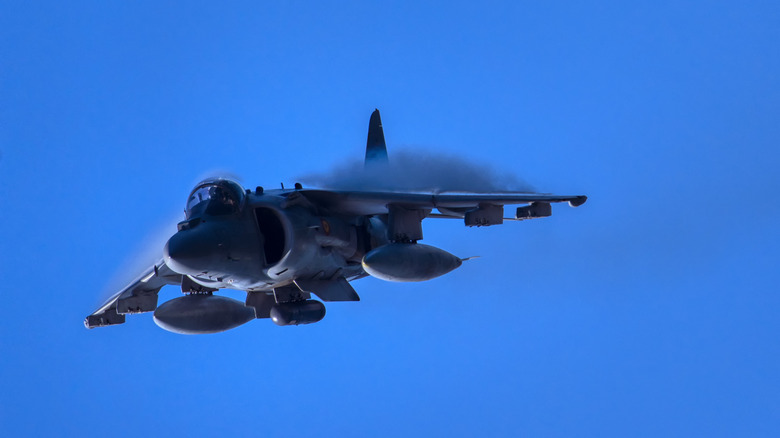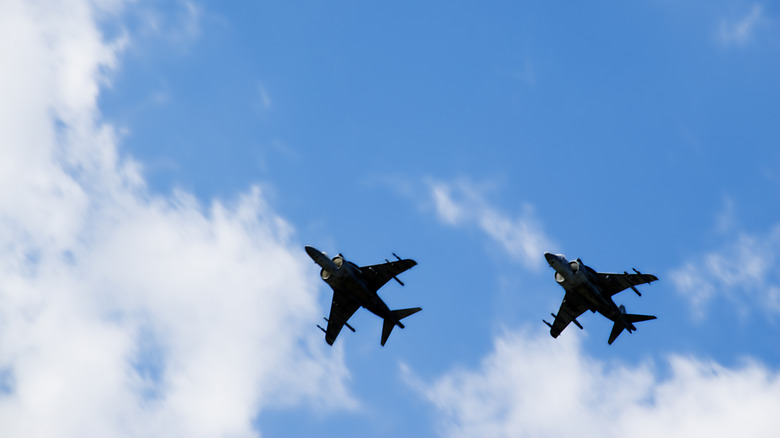Why The RAF No Longer Flies The Legendary Harrier II Fighter Jet
In 2010, the U.K. government pulled the plug on the Harrier II not because it failed in combat — far from it, as it had some incredible capabilities – but because of cold economics. The Strategic Defence and Security Review (SDSR) hit at a time when Britain faced a £38 billion defense budget shortfall. With two Queen Elizabeth-class aircraft carriers already too far along to cancel, something had to give. So, Joint Force Harrier, Britain's last V/STOL fast-jet strike capability, became a casualty.
Despite the Harrier GR9's versatility and recent £500 million upgrades, it was pitted directly against the Tornado GR4 in a zero-sum game. The Tornado had a broader weapons suite with strategic tools like Storm Shadow cruise missiles, and was already entrenched in Afghan operations. RAF brass argued the Harrier couldn't match the Tornado's flexibility for sustained ground attack missions.
In a blunt tradeoff, the government chose to retain Tornados and decommission all Harriers by the end of 2010. That left the U.K. without fixed-wing carrier strike jets until the F-35Bs arrived years later. The RAF didn't lose the Harrier to battle damage; it lost it to spreadsheets.
An icon with nowhere left to land
The legendary Harrier was originally made by Hawker Siddeley and designed to launch from almost anywhere, including unprepared runways and even no runways at all. But its options had dried up by 2010. The Royal Navy's Sea Harriers were already gone by 2006 , and the few remaining Invincible-class carriers were being decommissioned, with the last one out of service by 2014, and the new Queen Elizabeth-class ships weren't ready yet. That left the Harrier force in limbo.
It couldn't fulfill its naval strike role anymore, and its ground-based utility was being overshadowed by Tornado squadrons that had five times the mass. Once the carriers were pulled, the Harrier's case looked very weak indeed. While the Harrier GR9 still had solid gear – precision-guided bombs, sniper targeting pods, and helmet-mounted sights – its sea-based strength was no longer needed, and its land-based future was politically inconvenient.
Worse, its retirement wasn't gradual. Within two months of the SDSR, the U.K. culled the entire fleet in a hard stop, flying a final 16-ship formation in December 2010. The jets were sold to the U.S. Marine Corps for spares, but most sit dismantled in the Arizona desert, picked clean for parts to keep American Harriers flying.
Its legacy lives on, just not in British hands
From the Falklands War to Afghanistan, the Harrier II proved the value of V/STOL flight in the real world, not just theory. But the jet's fate in the U.K. was sealed by policy, not performance. That said, the Harrier continued flying, just not for Britain. The U.S. Marines kept their AV-8B Harrier IIs in the fight for years after the RAF bowed out, despite them being one of the most notoriously difficult military planes to fly.
They flew critical close air support missions in Iraq, Afghanistan, Libya, Syria, and Yemen. Unlike the Gulf War, where they dropped mostly unguided bombs, these Harriers hit targets with precision weapons, guided by LITENING pods and linked to troops in real-time. The AV-8B remained relevant through steady upgrades and tactical flexibility.
RAF pilots may no longer strap into that peculiar, powerful jump jet, but its influence lives on in every short takeoff and vertical landing that still makes headlines. The Harrier was pushed aside, but its legend never really left.


